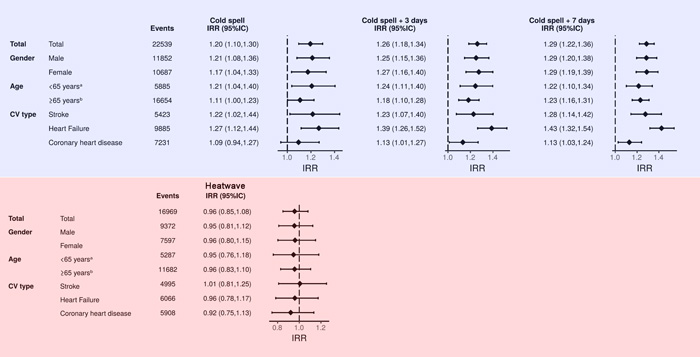| Follow @co2science |
Paper Reviewed
Ponjoan, A., Blanch, J., Alves-Cabratosa, L., Martí-Lluch, Comas-Cufí, M., Parramon, D., Garcia-Gil, M., Ramos, R. and Petersen, I. 2017. Effects of extreme temperatures on cardiovascular emergency hospitalizations in a Mediterranean region: a self-controlled case series study. Environmental Health 16: 32, doi:10.1186/s12940-017-0238-0.
Global warming has been postulated to pose numerous challenges to human health, including premature death due to heat-induced cardiovascular problems. However, a number of studies have refuted this claim (see, for example, the many reviews we have posted on the subject here), the latest of which comes from the nine-member research team of Ponjoan et al. (2017).
For their analysis, Ponjoan et al. analyzed the effects of both heat waves and cold spells on emergency hospitalizations due to cardiovascular diseases in Catalonia (a region of Spain in the Mediterranean basin) over the period 2006 to 2013. In doing so, they used the self-controlled case series statistical methodology to assess the relative incidence rate ratios (IRRs) of hospitalizations during the hot and cold waves in comparison to reference time periods with normal temperature exposure. Heat waves were defined as a period of at least 3 days in July and August in which the daily maximum temperatures were higher than the 95th percentile of daily maximum temperature for those two months. Cold waves were similarly defined as periods of at least 3 days in January and February when daily minimum temperatures were lower than the 95th percentile of daily minimum temperatures for those two months. IRRs were adjusted for age, time interval and air pollution. The number of hospitalizations due to cardiovascular diseases during January and February over the period of study was 22,611, whereas there were only 17,017 during July and August.
Results of the authors' analysis are shown in Figure 1 below. As can be seen there, during cold spells the incidence of cardiovascular hospitalizations increases by 20 percent, rising to 26 and 29 percent when a lag of 3 and 7 days are added to the cold spell. In contrast, Ponjoan et al. report that "the effect of heatwaves on overall cardiovascular hospitalizations was not significantly different from the null," adding that "no significant differences were observed when stratifying by sex, age or cardiovascular type categories" for either heat waves or cold spells. This latter finding challenges the oft-repeated concern that the elderly will disproportionately suffer more health maladies than younger people during such temperature departures (either hot or cold).
Clearly, given the results of this study, cold weather is the danger to be feared in terms of increasing rates of hospitalization for cardiovascular disease. And this being the case, perhaps we should all pray for a little global warming.

Figure 1. Incident rate ratios (IRR) for cardiovascular emergency hospitalization considering four exposures: cold spells, cold spells plus 3 day lag, cold spells plus 7 day lag, and heat waves. All models were adjusted by age, fortnight and air pollution. Results are shown stratified by gender, age groups and cardiovascular (CV) event type. Adapted from Ponjoan et al. (2017).




